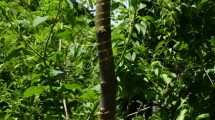Abstract
A study on the spatial distribution of the silkmoth Anaphe panda (Boisduval) cocoon nests, egg clusters and the host plant Bridelia micrantha (Hochst) Baill. was conducted in two different habitats of the Kakamega Forest of western Kenya: Ikuywa (indigenous forest) and Isecheno (mixed indigenous forest). Fhe mean densities of cocoon nests, egg clusters and B. micrantha were significantly different in the two blocks and were not semi-randomly distributed in the two habitats. The host plants were underdispersed in the indigenous forest, whereas they were overdispersed in the mixed indigenous forest. The cocoon nests were overdispersed and the silkmoth egg clusters were underdispersed in the two blocks of forest. This study reveals that A. panda tends to distribute its egg clusters uniformly over the lower and middle crown of B. micrantha with a preference to eastern localization and confirms the insufficient presence of populations of this silkmoth in a mixed indigenous forest compared with an indigenous forest. Consequently, indigenous forests should be managed in a sustainable way and more indigenous tree species should be used in reforestation campaigns.
Similar content being viewed by others
References
Ashiru M. O. (1988) Determination of the number of instars of the silkworm Anaphe veneta Butler (Lepidoptera: Notonidae). Insect Science and Its Application 9, 405–410.
Garmin Ltd (2002) Garmin Software. AV Garmin Ltd.
Geertsema H. (1975) Studies on the biology, ecology and control of the pine tree emperor moth, Nudaurelia cytherea cytherea (Fabr.) (Lepidoptera: Saturniidae). Annate Universiteit Van Stellenbosch 50 (1), 170.
Gowdey C. C. (1953) On the utilisation of an indigenous silkworm (Anaphe infracta Walsingham) in Uganda. Bulletin of Entomological Research 3, 269–274.
Jolly M. S., Sen S. K., Sonwalker T. N. and Prasad G. K. (1979) Non-mulberry silks. FAO Agricultural Services Bulletin 29, 164.
KIFCON (1994) Kenya Indigenous Forest Conservation Programme Phase 1 Report. Centre for Biodiversity, Nairobi.
Kioko E. N., Raina S. K. and Mueke J. M. (1999) Conservation of the African wild silkmoths for economic incentives to rural communities of the Kakamega Forest in Kenya. International Journal of Wild Silkmoths and Silk 4, 1–5.
Kioko E. N., Raina S. K. and Mueke J. M. (2000) Survey on diversity of wild silk moths species in East Africa. East African Journal of Science 2 (1), 1–6.
Munthali S. M. and Mughogho E. C. (1992) Economic incentives for conservation bee-keeping and Saturni-dae caterpillar utilization by rural communities. Biodiversity and Conservation 1, 143–154.
Oberprieler R. (1994) The Emperor Moths of Namibia. Ecoguild, Hartbeespoort.
Oliveira J. F. S., De Carvalho R. F. X., De Sousa B. and Simao M. M. (1976) The nutritional value of four insects consumed in Angola. Ecology of Food and Nutrition 5, 91–97.
Pottinger R. P. and LeRoux E. J. (1971) The biology and dynamics of Lithocolletis blancardella (Lepidoptera: Gracillariidae) on apple in Quebec. Memoirs of the Entomological Society of Canada 77, 437.
Raina S. K. (2004) On developing incentives for community participation in forest conservation through the use of commercial insects in Kenya. First training course, 19 November–10 December 2004. ICIPE, 213 pp.
Raje U. S. (1999) Prospects and problems of silk industry in African countries. In Sericulture and Apiculture: Prospects for the New Millennium. Proceedings of the Second International Workshop on Conservation and Utilization of Commercial Insects (28 November–1 December 1999) ISBN 92 9064 133 9. ICIPE Science Press, Nairobi.
SAS Institute (2003) SAS/STAT Users’ Guide, version 8, 6th edn., vol. 2. SAS Institute, Cary, North Carolina.
Southwood T. R. E. (1968) Ecological Methods with Particular Reference to the Study of Insect Populations. Methuen, London. 391 pp.
Zar J. H. (2005) Biostatistical Analysis. Third Indian (reprint). Pearson Education (Singapore) Pte. Ltd, Delhi. 663 pp.
Author information
Authors and Affiliations
Corresponding author
Rights and permissions
About this article
Cite this article
Mbahin, N., Raina, S.K., Kioko, E.N. et al. Spatial distribution of cocoon nests and egg clusters of the silkmoth Anaphe panda (Lepidoptera: Thaumetopoeidae) and its host plant Bridelia micrantha (Euphorbiaceae) in the Kakamega Forest of western Kenya. Int J Trop Insect Sci 27, 138–144 (2008). https://doi.org/10.1017/S1742758407859662
Accepted:
Published:
Issue Date:
DOI: https://doi.org/10.1017/S1742758407859662




